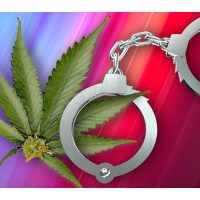Pot Decriminalization Has Dramatically Lowered Juvenile Arrests

California has throttled back its war on drugs by taking fewer shots at juveniles.
A study released by the Center on Juvenile and Criminal Justice (CJCJ) found that marijuana possession arrests decreased 61% after January 2011 when California reduced the penalty from a misdemeanor to an infraction for possession of under one ounce. Police made only 5,831 juvenile possession arrests in 2011, compared to 14,991 the year before.
While misdemeanors can involve arrest, a fine and jail time, infractions are treated more like traffic tickets. The decriminalization legislation, Senate Bill 1449, applied to both adults and juveniles. Marijuana possession of under an ounce was a felony until Senate Bill 95 was passed in 1976.
Fewer pot arrests were at the heart of California’s celebrated 20% decline in juvenile arrests last year. Overall, juvenile drug arrests dropped 47%, felonies were down 17% and misdemeanors fell 21%. Homicide arrests in the group fell 26%, violent crime slipped 16%, property-crime arrests were off 16% and rape arrests were down 10%.
Taking a longer view, total arrests, felonies, rape, homicide, property crime and misdemeanor/status offense rates are at their lowest historical levels. Robbery and assault rates are higher today than 60 years ago, but haven’t been this low since 1967.
And even these figures may be underestimating the juvenile crime drop-off, according to the justice center. Back in the 1950s, a lot of behavior, including drug use, was categorized as “delinquent tendencies.” An average of 90,000 wayward youths got that designation 60 years ago, compared to 22,000 last year.
Although the legal change has had an undeniable effect on juvenile crime statistics, the study says an explanation for the crime drop cannot be easily explained. In fact, some of the conventional wisdom is probably dead wrong. “Get tough on crime” proponents may claim some credit for the decline, but falling arrests for truancy, curfew violation and other types of incorrigibility indicate there is less police supervision of youths, not more. Demographic changes, involving increases in Latino and African-American populations that have historically higher arrest rates, would suggest juvenile rates should be going up, not down. The report further denigrates cultural influences (like the internet), family and community explanations and structural changes (like police tactics and statistics gathering).
The researchers were left with just two factors. An economic improvement in the poorest, crime-ridden neighborhoods (youth poverty is actually up overall) and the new marijuana law. While acknowledging that the picture is still incomplete, they credit those two changes with improving California’s arrest rates from among the worst nationally in the 1970s to about average now.
–Ken Broder
To Learn More:
Marijuana Decriminalization Law Brings Down Juvenile Arrests in California (by Susan Ferriss, The Center for Public Integrity)
California Youth Crime Plunges to All-Time Low (by Mike Males, Center on Juvenile and Criminal Justice) (pdf)
Washington’s and Colorado’s Marijuana Legalization Schemes Are No Model for California (by Mike Males, Center on Juvenile and Criminal Justice)
Senate Bill 1449 (California Legislative Information)
- Top Stories
- Controversies
- Where is the Money Going?
- California and the Nation
- Appointments and Resignations
- Unusual News
- Latest News
- California Forbids U.S. Immigration Agents from Pretending to be Police
- California Lawmakers Urged to Strip “Self-Dealing” Tax Board of Its Duties
- Big Oil’s Grip on California
- Santa Cruz Police See Homeland Security Betrayal in Use of Gang Roundup as Cover for Immigration Raid
- Oil Companies Face Deadline to Stop Polluting California Groundwater





